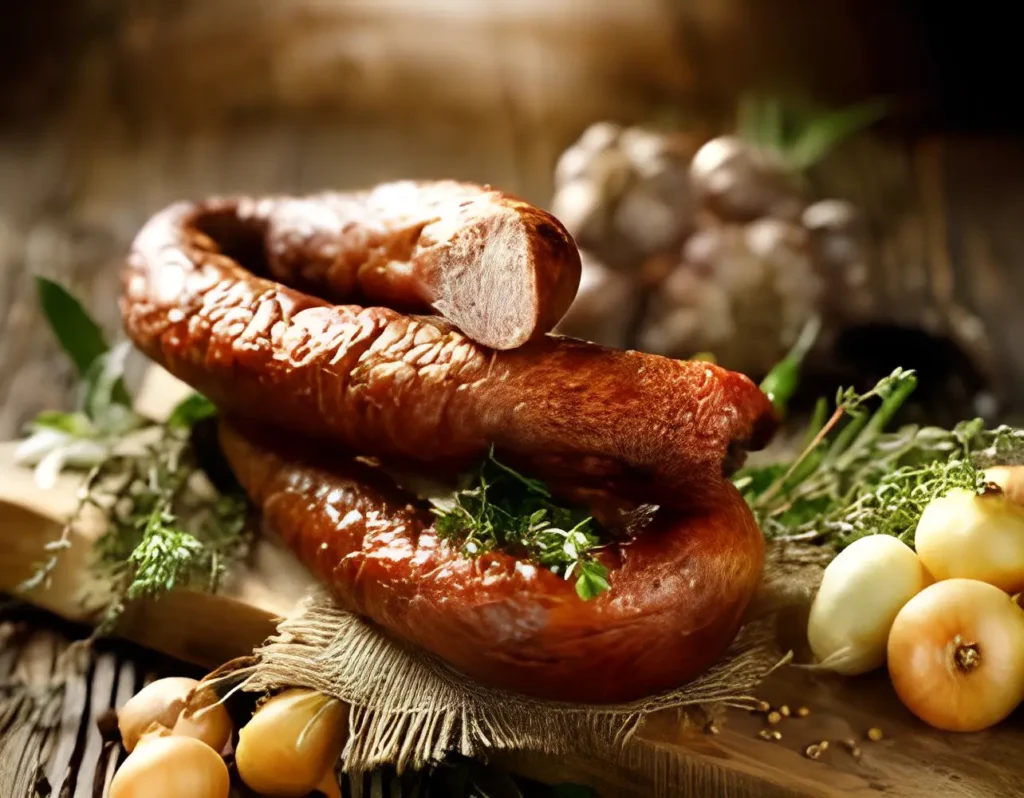In the heart of every culture lies a culinary tradition that tells the story of its people, their history, and their way of life. Among these, the Polish kielbasa stands out as a testament to Poland’s rich culinary heritage. This article dives deep into the traditional ways to enjoy kielbasa, exploring its varieties, cooking methods, and the best ways to serve this beloved sausage. From the smoky flavors of a grilled piece to the comforting warmth of a dish served with kielbasa, we’ll uncover the secrets to savoring this Polish delicacy just as it’s been enjoyed for generations. So, let’s embark on this flavorful journey, shall we?
Introduction to Kielbasa
Ah, kielbasa – the mere mention of this word can make mouths water and hearts warm with anticipation. This Polish sausage is more than just a food item; it’s a cultural icon, a staple of Polish cuisine that has found its way into hearts and homes around the globe. But what exactly is kielbasa, and why does it hold such a special place in Polish culinary traditions?
Kielbasa traces its roots back to the times when preserving meat was not just a culinary practice but a necessity. This smoked sausage, crafted with care and seasoned with a blend of spices, was a way to ensure that nothing went to waste and that the flavors of the meat were enhanced and preserved. Today, it stands as a symbol of Polish hospitality and culinary prowess, enjoyed in countless dishes and settings.
In Poland, kielbasa is not just one type of sausage but a category that encompasses a variety of styles and flavors. From the lightly smoked and mildly spiced pork sausage popular in North America and parts of Europe to the diverse array found in Poland itself – ranging from raw to precooked and even dry-aged – kielbasa is a testament to the creativity and tradition of Polish butchers and cooks.
So, whether you’ve picked up a prepackaged, mass-market kielbasa from the supermarket or you’re delving into the artisan varieties, there’s a traditional way to enjoy this sausage that will bring out its best flavors. Let’s explore the world of kielbasa, including its types, traditional ways of eating it, and how you can incorporate a taste of Poland into your kitchen.
Exploring the Varieties

When it comes to kielbasa, variety really is the spice of life. This Polish sausage comes in many forms, each with its own unique flavor profile and cooking recommendations. Understanding these varieties is the first step to truly appreciating the traditional ways to enjoy kielbasa. So, let’s slice into the world of kielbasa and discover the differences that make each type special.
Precooked Kielbasa
Precooked kielbasa is perhaps the most accessible variety outside of Poland, readily available in many supermarkets. This type of kielbasa, known as “parzona” in Polish, is heat-treated and can be eaten straight from the package. However, further cooking enhances its flavors. The precooked variety is versatile, lending itself well to a range of cooking methods from sautéing to grilling, each method bringing out a different aspect of its smoky, savory taste.
Fresh (Raw) Kielbasa
Fresh, or raw, kielbasa is a delight for the senses, offering a more direct connection to traditional Polish culinary practices. One popular variety is Biała, often featured in the famous Żurek soup, a staple of Polish cuisine. Unlike its precooked counterpart, fresh kielbasa requires cooking before consumption. Boiling, frying, or baking are common methods, each enhancing the sausage’s natural flavors and textures. To explore traditional Polish dishes, using fresh kielbasa in your cooking is essential.
Dry-Cured/Dry-Aged Kielbasa
For a taste that truly stands out, dry-cured or dry-aged kielbasa offers a concentrated burst of flavor. Varieties like Myśliwska and Krakowska are enjoyed as appetizers, snacks, or even as a tasty addition to sandwiches (kanapki). These sausages are not meant to be cooked further but savored for their rich, complex flavors developed through the curing process. They embody the art of Polish sausage-making, with each bite a testament to the skill and tradition that has been passed down through generations.
Exploring the varieties of kielbasa opens up a world of culinary possibilities. Whether you’re enjoying a simple meal at home or hosting a feast for friends and family, there’s a type of kielbasa that fits every occasion. By appreciating the differences between these varieties, you can start to incorporate traditional Polish flavors into your cooking, bringing a piece of Poland to your table. For those eager to learn more about the culinary delights of Poland, the Polish National Tourist Office offers a wealth of information on traditional dishes and cooking techniques, inviting you to explore the rich tapestry of Polish cuisine.
Traditional Ways to Eat Kielbasa

Diving into the traditional ways to enjoy kielbasa is like opening a door to a world where every bite tells a story. From the smoky aroma filling the air as it grills to the sizzle of sausage frying in a pan, each method of preparation brings out unique flavors and textures. Let’s explore how to cook and serve kielbasa in ways that pay homage to its rich heritage.
Cooking Precooked Kielbasa
While it might seem like a shortcut, precooked kielbasa offers a canvas for culinary creativity. Here are some traditional methods to elevate it from simple to sublime:
- Sautéing: Quick and straightforward, sautéing kielbasa on the stove brings out a delightful browning that enhances its flavor. Whether you slice it into rounds or cook it whole, a little oil and medium heat can turn this sausage into a crispy, juicy delight.
- Roasting: For those who prefer a hands-off approach, roasting kielbasa in the oven at 360°F (180°C) until it’s nicely browned creates a succulent centerpiece. This method is perfect for a lazy Sunday dinner or when you’re multitasking in the kitchen.
- Grilling: Grilling kielbasa is a summer tradition, with the charred lines adding both flavor and visual appeal. It’s a foolproof way to enjoy kielbasa, especially since it’s already precooked, eliminating any worries about it being underdone.
- Air Frying: For a modern twist, air frying kielbasa offers the same great taste as sautéing but with less mess. It’s a quick way to achieve that desirable crispy exterior without standing over a stove.
Preparing Fresh Kielbasa
Fresh kielbasa requires a bit more care in preparation but rewards you with unparalleled taste and texture:
- Boiling: Often the first step in preparing fresh kielbasa, boiling gently cooks the sausage through without drying it out. This method is especially popular when making kielbasa for soups or stews.
- Sautéing: After a brief boil, sautéing fresh kielbasa can add a deliciously crispy layer to its exterior. It’s a fantastic way to prepare it for serving with sauerkraut or within a sandwich.
- Roasting: Roasting fresh kielbasa in the oven, especially when marinated with spices like marjoram, garlic, and onions, infuses it with flavor and creates a succulent dish that’s hard to resist.
- Grilling: Grilling fresh kielbasa after blanching it in hot water is a traditional method that ensures it’s fully cooked while still getting those desirable grill marks and smoky flavor.
Serving Suggestions
The beauty of kielbasa lies not just in its flavors but also in how it brings people together. Serving kielbasa with traditional condiments like mustard or horseradish and sides such as potato salad or sauerkraut turns a simple meal into a feast. For an authentic experience, consider exploring traditional Polish recipes that feature kielbasa as a key ingredient. Websites like Taste of Home offer a treasure trove of recipes that can inspire your next meal and introduce you to new ways of enjoying kielbasa.
By embracing these traditional cooking and serving methods, you’re not just preparing a meal; you’re participating in a culinary tradition that has been cherished for generations. Whether you’re a seasoned kielbasa aficionado or new to its delights, there’s always something new to discover in the rich tapestry of Polish cuisine.
Recipes and Serving Ideas
Kielbasa is not just a sausage; it’s a versatile ingredient that can transform any meal into a celebration of flavor. Whether you’re looking for a quick weeknight dinner or planning a festive gathering, there’s a kielbasa recipe that fits the bill. Let’s dive into some traditional and innovative ways to incorporate kielbasa into your cooking repertoire.
One-pot Kielbasa with Pasta
This hearty dish combines the smoky flavors of kielbasa with the comforting texture of pasta, all cooked in a single pot for ease and convenience. Start by sautéing slices of kielbasa until they’re nicely browned, then add your favorite vegetables (like bell peppers and onions) and cook until soft. Toss in the pasta, a can of diced tomatoes, and enough broth to cover. Simmer until the pasta is al dente, and finish with a sprinkle of fresh herbs for a meal that’s both satisfying and simple to make.
Kielbasa and Sauerkraut
A classic pairing, kielbasa and sauerkraut marry the sausage’s rich flavors with the tangy crunch of fermented cabbage. This dish is a staple at Polish tables, especially during celebrations. To make it, brown slices of kielbasa in a pan, then add sauerkraut (rinsed and drained if you prefer a milder taste), a splash of apple cider vinegar, and a pinch of sugar. Let it simmer until the flavors meld together. Serve with mashed potatoes or rye bread for a traditional meal that warms the soul.
Kielbasa and Cabbage
For a lighter take on kielbasa dishes, pairing it with cabbage creates a balanced and nutritious meal. Slice the kielbasa and sauté it with onions until golden. Add chopped cabbage, a bit of chicken stock, and season with salt, pepper, and a dash of paprika. Cover and cook until the cabbage is tender. This simple yet flavorful dish showcases the kielbasa‘s versatility and is perfect for a quick dinner.
Leczo with Kielbasa and Peppers
Leczo is a colorful and spicy stew that’s a fantastic way to enjoy kielbasa. It’s a melody of bell peppers, tomatoes, onions, and kielbasa, simmered together until thick and hearty. For an authentic touch, add a bit of smoked paprika and marjoram. Leczo can be served on its own or with a side of crusty bread to soak up the delicious sauce. It’s a comforting dish that brings a burst of flavor to any table.
For those eager to explore more traditional Polish recipes that feature kielbasa, Taste of Home offers a wide range of dishes from simple to elaborate, each bringing a taste of Poland to your kitchen. Whether you’re cooking for a special occasion or just looking to add some variety to your meals, incorporating kielbasa into your dishes is a surefire way to delight your taste buds and introduce your family to the rich culinary traditions of Poland.
Frequently Asked Questions
When it comes to enjoying kielbasa, questions abound. Whether you’re a seasoned chef or a curious newcomer, there’s always something new to learn about this beloved Polish sausage. Let’s tackle some of the most frequently asked questions to help you get the most out of your kielbasa experience.
Is it necessary to score kielbasa before cooking?
The debate on whether to score kielbasa before cooking is a longstanding one. Traditionalists argue that scoring the sausage can cause it to lose some of its juices, leading to a drier outcome. However, if you’re working with a vacuum-packed, mass-produced kielbasa, scoring can help render out excess fat and improve browning. In short, for high-quality, artisan kielbasa, it’s best to leave it whole to preserve its juiciness. For other types, feel free to score if you prefer.
Can kielbasa be eaten without cooking?
Precooked kielbasa is safe to eat straight from the package since it has already been heat-treated. However, to enhance its flavor and texture, it’s recommended to cook it further using methods like sautéing, grilling, or roasting. Fresh (raw) kielbasa, on the other hand, must be cooked thoroughly before consumption to ensure food safety.
How to store kielbasa?
Storing kielbasa properly is key to maintaining its quality and safety. Precooked kielbasa can be kept in the refrigerator for up to two weeks unopened or up to seven days after opening. For longer storage, you can freeze kielbasa for up to three months. Fresh kielbasa should be cooked within two days of purchase or can be frozen for up to three months. Always thaw frozen kielbasa in the refrigerator before cooking. For more detailed information on storing and handling meats safely, the Food Safety Guidelines website is an excellent resource.
By addressing these common queries, we hope to enhance your cooking and enjoyment of kielbasa. Remember, the key to a delicious kielbasa dish lies not just in how it’s prepared, but also in understanding the traditions and techniques that have made it a staple of Polish cuisine. Whether you’re enjoying a simple grilled kielbasa or incorporating it into a complex stew, each bite is a nod to the rich culinary heritage of Poland.
Conclusion
Kielbasa, a symbol of Polish culinary heritage, offers more than just a taste experience—it’s a journey through tradition and culture. This article has guided you through the varieties of kielbasa, traditional cooking methods, and serving suggestions that highlight its versatility and rich flavor. We’ve also answered common questions to enhance your kielbasa experience, ensuring you cook, serve, and store it like a pro.
As we wrap up, remember that kielbasa is not just food; it’s a celebration of Polish culture and the joy of sharing meals. Whether you’re exploring kielbasa for the first time or revisiting familiar flavors, there’s always something new to discover. So, gather your loved ones, share the warmth of kielbasa-infused dishes, and continue the tradition of bringing people together through the love of good food. Here’s to kielbasa—a simple sausage with the power to unite and delight.

